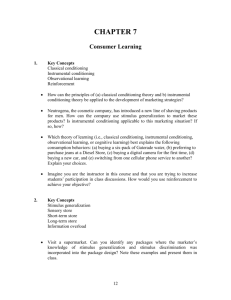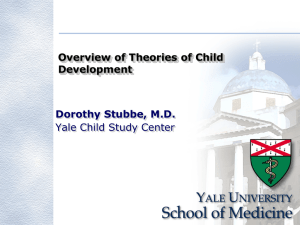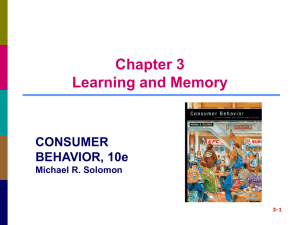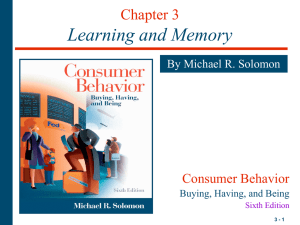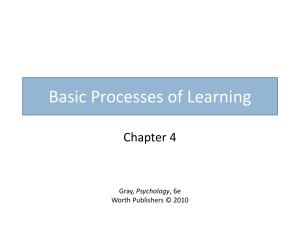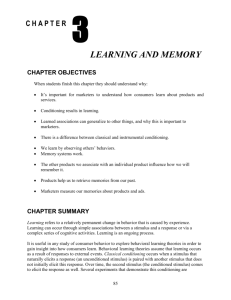Learning & Memory - Michael Kalsher Home
advertisement
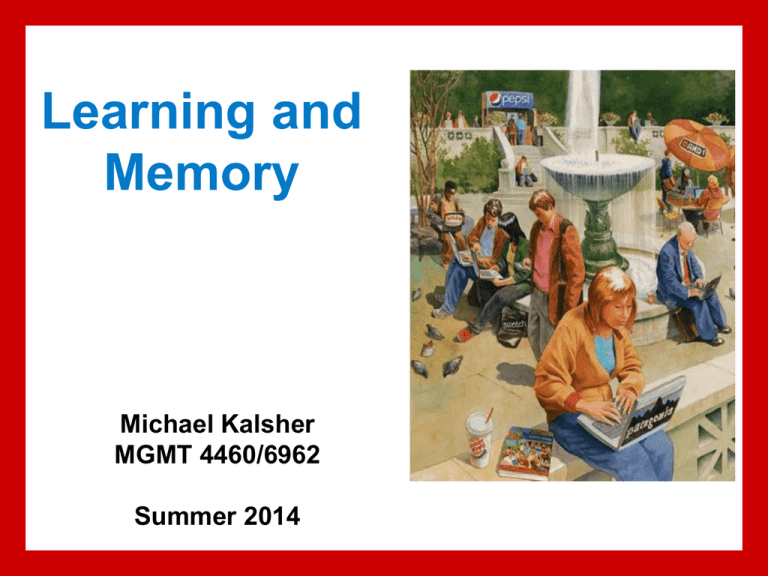
Learning and Memory Michael Kalsher MGMT 4460/6962 Summer 2014 The Learning Process • Products are reminders of life experiences • Good experiences/associations with products leads to brand equity/loyalty • Learning: a relatively permanent change in behavior or behavior potential caused by experience – Basic models of the learning process • Behavioral learning theories (operant, classical conditioning) • Cognitive models of learning (incidental, observational) 3-2 Behavioral Learning Theories Classical Learning theories focus on relationships established among external events (stimuli) -- Stimulus-stimulus; Stimulus-response Cognitive Learning Theories – “Black box” vs. Observable behavior Stimulus Consumer Response 3-3 Classical Conditioning • Ivan Pavlov • CS + UCS = response – Repeated Contiguous parings vs. One-Trial Learning • Brand names as CS – Credit card as CS • Music, humor, imagery • CS first, then UCS 3-4 Classical Conditioning Repetition of exposure – Type of medium used • Combination usually best • Spaced exposures and alternating media formats – Extinction • Izod Lacoste crocodile extended to other types of clothes (e.g., baby clothes, other items) – Beware of… • Advertising wear-out • Frequent product encounters & extinction 3-5 Classical Conditioning Stimulus Generalization – Tendency of stimuli similar to a CS to evoke similar CRs (sometimes termed a “Halo effect”) • “Piggybacking” strategy • Masked branding (hiding a product’s true origin) – Family branding, product line extensions, licensing, look-alike packaging Does this look like Miller Beer? 3-6 Your turn … Identify some important characteristics of a product with a well-known brand name. – Based on these attributes, generate a list of possible brand extension or licensing opportunities – Name some others that would most likely not be accepted by consumers. 3-7 Classical Conditioning Stimulus Discrimination Stresses that certain competitor products are “not as good as the original brands” Which one? – Brand positioning • Unique attributes of brand – Anti-Counterfeiting Coalition combats “knockoffs” 3-8 Instrumental and Operant Conditioning http://www.youtube.com/watch?v=yhvaSEJtOV8 https://www.youtube.com/watch?v=qy_mIEnnlF4 3-9 Instrumental and Operant Conditioning • ABC Learning Antecedents Behavior Emitted vs. Elicited behavior Consequences • Reinforcement vs. Punishment – Response increase vs. decrease • Negative reinforcement is NOT punishment! • Positive vs. Negative (apply vs. remove) • Extinction 3-10 Instrumental and Operant Conditioning • Stimulus Control • Stimulus – Discrimination – Generalization 3-11 Operant Conditioning Reinforcement schedules include… – Fixed-interval (seasonal sales) – Variable-interval (secret shoppers) – Fixed-ratio (grocery-shopping receipt programs) – Variable-ratio (slot machines) 3-12 Cognitive Learning Theory • People = problem solvers • Tolman’s Demonstration 3-13 Observational Learning We watch others and note the consequences they receive for behaviors – Vicarious learning – Socially desirable models/celebrities who use or do not use their products https://www.youtube.com/watch?v=kHMncI5mTJk CBS memo: "Please be sure that buttocks and female breasts are adequately covered. Thong type costumes are problematic. Please avoid exposing bare fleshy under curves of the buttocks and buttock crack.” 3-14 Observational Learning Modeling: imitating others’ behavior – Bobo doll experiment ATTENTION RETENTION PRODUCTION PROCESSES MOTIVATION OBSERVATIONAL LEARNING 3-15 Role of Memory in Learning • Memory: acquiring information and storing it over time so that it will be available when needed • Information-processing approach – Mind = computer & data = input/output EXTERNAL INPUTS ENCODING STORAGE RETRIEVAL 3-16 Encoding The way we encode information can help us retain it later – Sensory meaning (how it looks) – Semantic meaning (what it means) – Personal relevance • Episodic/flashbulb memories • Product information conveyed as a narrative 3-17 Memory Systems SENSORY MEMORY SHORT-TERM MEMORY ATTENTION LONG-TERM MEMORY ELABORATIVE REHEARSAL 3-18 Chunking Informational unit in short-term memory (STM) – Brand name – Area code of telephone number – Optimal size for retrieval = 7 (+ or - 2) 3-19 Associative Networks Activation models of memory – Associative network of related information • Knowledge structures of interconnected nodes • Hierarchical processing model 3-20 Associative Networks 3-21 Semantic Associations • Intel = “intelligent” + “electronics” • Viagra ~ Niagara (Falls) • Qualcomm = “quality” + “communications” • p, b, t, d = slow • f, v, s, z = fast • Blackberry PDA – b = reliability & “berry” = smallness 3-22 Levels of Knowledge • Individual nodes = meaning concepts • Two (or more) connected nodes = proposition (complex meaning) • Two or more propositions = schema – We more readily encode information that is consistent with an existing schema – Service scripts 3-23 Retrieval for Purchase Decisions Retrieving information often requires appropriate factors/cues: – Physiological factors – Situational factors • Consumer attention; pioneering brand; descriptive brand names – Viewing environment • continuous activity; commercial order in sequence – Post-experience advertising effects 3-24 Retrieval for Purchase Decisions (Cont’d) Appropriate factors/cues for retrieval (cont’d): – State-dependent retrieval/mood congruence effect – Familiarity – Salience/von Restorff Effect (mystery ads) – Visual memory vs. verbal memory 3-25 Factors Influencing Forgetting • Decay • Interference – Retroactive vs. proactive • Part-list cueing effect 3-26 Products as Memory Markers • Furniture, visual art, and photos call forth memories of the past • Autobiographical memories – The marketing power of nostalgia – Retro brand – Nostalgia index 3-27 Measuring Memory for Marketing Stimuli • Recognition vs. recall • The Starch Test • Problems with memory measures – Response biases – Memory lapses – Memory for facts vs. feelings 3-28 The Starch Test • A classic series of tests pioneered during the 1920s by Daniel Starch (1883-1979), a psychologist who specialized in advertising research. The tests measure audience recall of advertisements in newspapers and magazines. • The tests were the first examples of what Starch named "recognition research," a method that is now widely accepted and used. • He founded Daniel Starch and Associates, which conducted the tests for decades. The firm is now part of United Business Media plc. 3-29 Starch Test: How You Do It • The researcher interviews readers of print publications and asks each interviewee if s/he has recently read certain publications. If an interviewee has recently read a publication, the researcher asks the interviewee which issue he read, and which ads he noticed in that issue. This is "unaided recall”. • Then the researcher produces the issue and asks the interviewee to look inside it. • After the interviewee has looked, the researcher asks him about a certain advertisement in that issue (this is "aided recall"). • The researcher keeps track of the percentage of subjects who: – Remembered seeing a specific ad ("noted"). – Saw or read part of the ad ("seen/associated"). – Read at least half of the ad ("read most"). 3-30
